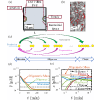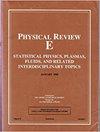Dynamics of waste proteins in brain tissue: Numerical insights into Alzheimer's risk factors
IF 2.4
3区 物理与天体物理
Q1 Mathematics
引用次数: 0
Abstract
Over the past few decades, research has indicated that the buildup of waste proteins, like amyloid- (), in the brain's interstitial spaces is linked to neurodegenerative diseases like Alzheimer's, but the details of how such proteins are removed from the brain are not well understood. We have developed a numerical model to investigate the aggregation and clearance mechanisms of in the interstitial spaces of the brain. The model describes the volume-averaged transport of in a segment of the brain interstitium modeled as a porous medium, oriented between the perivascular space (fluid-filled channel surrounding a blood vessel) of a penetrating arteriole and that of a venule. Our numerical approach solves coupled advection-diffusion-aggregation equations that model the production, aggregation, fragmentation, and clearance of species of . We simulate species to investigate the oligomer-size dependence of clearance and aggregation. We introduce a timescale plot that helps predict buildup for different neurological conditions. We show that a sudden increase in monomer concentration, as occurs in conditions like traumatic brain injury, leads to significant plaque formation, which can qualitatively be predicted using the timescale plot. Our results also indicate that impaired protein clearance (as occurs with aging) and fragmentation are both mechanisms that sustain large intermediate oligomer concentrations. Our results provide novel insight into several known risk factors for Alzheimer's disease and cognitive decline, and we introduce a unique framing of dynamics as a competition between different timescales associated with production rates, aggregation rates, and clearance conditions.

脑组织中废弃蛋白质的动态变化:用数字洞察阿尔茨海默氏症的风险因素
过去几十年的研究表明,大脑间隙中淀粉样蛋白-β(Aβ)等废弃蛋白质的堆积与阿尔茨海默氏症等神经退行性疾病有关,但人们对如何从大脑中清除这些蛋白质的细节还不甚了解。我们建立了一个数值模型来研究 Aβ 在大脑间隙中的聚集和清除机制。该模型描述了 Aβ 在一段被模拟为多孔介质的脑间质中的体积平均传输,该段脑间质位于穿支动脉的血管周围空间(血管周围充满液体的通道)和静脉的血管周围空间之间。我们的数值方法求解了 N 个耦合平流-扩散-聚集方程,模拟了 N 种 Aβ 的生成、聚集、破碎和清除。我们模拟了 N=50 个物种,以研究清除和聚集的低聚物大小依赖性。我们引入了一个时间刻度图,有助于预测不同神经状况下的 Aβ 积累情况。我们发现,单体浓度的突然增加(如在脑外伤等情况下)会导致大量斑块的形成,而这可以通过时标图进行定性预测。我们的研究结果还表明,蛋白质清除能力受损(如衰老)和碎裂都是维持大量中间寡聚体浓度的机制。我们的研究结果为阿尔茨海默病和认知能力衰退的几个已知风险因素提供了新的见解,并将 Aβ 动态的独特框架描述为与生成率、聚集率和清除条件相关的不同时标之间的竞争。
本文章由计算机程序翻译,如有差异,请以英文原文为准。
求助全文
约1分钟内获得全文
求助全文
来源期刊

Physical review. E
物理-物理:流体与等离子体
CiteScore
4.60
自引率
16.70%
发文量
0
审稿时长
3.3 months
期刊介绍:
Physical Review E (PRE), broad and interdisciplinary in scope, focuses on collective phenomena of many-body systems, with statistical physics and nonlinear dynamics as the central themes of the journal. Physical Review E publishes recent developments in biological and soft matter physics including granular materials, colloids, complex fluids, liquid crystals, and polymers. The journal covers fluid dynamics and plasma physics and includes sections on computational and interdisciplinary physics, for example, complex networks.
 求助内容:
求助内容: 应助结果提醒方式:
应助结果提醒方式:


